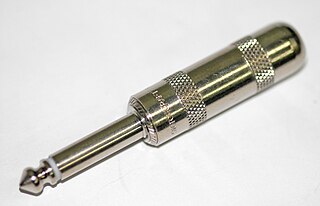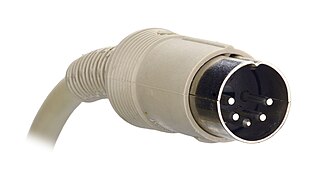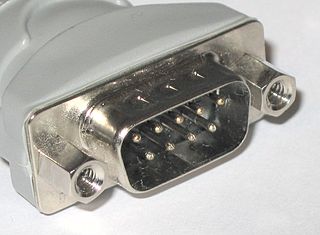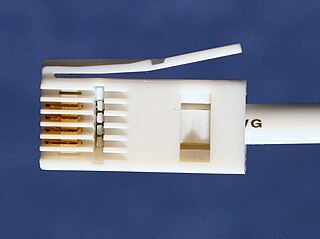History
The TAE system was introduced in the late 1980s before the German government-owned institution Deutsche Bundespost (DBP, German Federal Post) was divided into Deutsche Post (postal service), Deutsche Telekom (telecommunication services) and Postbank (financial services). Previously, the older ADo [ de ] type connectors had been used, or telephones had been hardwired to their (VDo [ de ]) wall sockets, and only officially approved telephones (legally distributable only by the DBP) were allowed to be connected to the telephone system. Furthermore, telephones and other communication devices could only be leased from the DBP and not be sold or bought on the free market.
The introduction of the TAE system was the practical enabling technology of the legal specification in Germany that communication terminal equipment should be in the responsibility of end users. Subsequently, many communication devices became available in the open market that could be plugged into standard TAE sockets. Adaptors allow for connecting devices with registered jacks that are more prevalent internationally.
Today, TAE connectors are common in Germany and other central European countries like Liechtenstein and Luxembourg. Modern TAE sockets also contain circuits referred to as passiver Prüfabschluss, meaning passive test termination. This provides a discernible condition to the telephone exchange indicating that the line is continuous to the TAE-connected device.

A 600 series connector is an obsolete three-pin connector with up to six conductors.

Thousands of configurations of connectors are manufactured for power, data, and audiovisual applications. Electrical connectors can be divided into four basic categories, differentiated by their function:

A phone connector, also known as phone jack, audio jack, headphone jack or jack plug, is a family of electrical connectors typically used for analog audio signals. The standard is that a plug will connect with a jack.

A registered jack (RJ) is a standardized telecommunication network interface for connecting voice and data equipment to a service provided by a local exchange carrier or long distance carrier. Registration interfaces were first defined in the Universal Service Ordering Code (USOC) system of the Bell System in the United States for complying with the registration program for customer-supplied telephone equipment mandated by the Federal Communications Commission (FCC) in the 1970s. They were subsequently codified in title 47 of the Code of Federal Regulations Part 68. Registered jack connections began to see use after their invention in 1973 by Bell Labs. The specification includes physical construction, wiring, and signal semantics. Accordingly, registered jacks are primarily named by the letters RJ, followed by two digits that express the type. Additional letter suffixes indicate minor variations. For example, RJ11, RJ14, and RJ25 are the most commonly used interfaces for telephone connections for one-, two-, and three-line service, respectively. Although these standards are legal definitions in the United States, some interfaces are used worldwide.

The DIN connector is an electrical connector that was originally standardized in the early 1970s by the Deutsches Institut für Normung (DIN), the German national standards organization. There are DIN standards for various different connectors.

The D-subminiature or D-sub is a common type of electrical connector. They are named for their characteristic D-shaped metal shield. When they were introduced, D-subs were among the smallest connectors used on computer systems.

"Schuko" is a registered trademark referring to a system of AC power plugs and sockets that is defined as "CEE 7/3" (sockets) and "CEE 7/4" (plugs). A Schuko plug features two round pins of 4.8 mm diameter for the line and neutral contacts, plus two flat contact areas on the top and bottom side of the plug for protective earth (ground). The socket has a predominantly circular recess which is 17.5 mm deep with two symmetrical round apertures and two earthing clips on the sides of the socket positioned to ensure that the earth is always engaged before live pin contact is made. Schuko plugs and sockets are symmetric AC connectors. They can be mated in two ways, therefore line can be connected to either pin of the appliance plug. As with most types of European sockets, Schuko sockets can accept Europlugs. Schuko plugs are considered a very safe design when used with Schuko sockets, but they can also mate with other sockets to give an unsafe result.
AC power plugs and sockets connect electric equipment to the alternating current (AC) mains electricity power supply in buildings and at other sites. Electrical plugs and sockets differ from one another in voltage and current rating, shape, size, and connector type. Different standard systems of plugs and sockets are used around the world.

A telephone jack and a telephone plug are electrical connectors for connecting a telephone set or other telecommunications apparatus to the telephone wiring inside a building, establishing a connection to a telephone network. The plug is inserted into its counterpart, the jack, which is commonly affixed to a wall or baseboard. The standards for telephone jacks and plugs vary from country to country, though the 6P2C style modular plug has become by far the most common type.

IEC 60309 is a series of international standards from the International Electrotechnical Commission (IEC) for "plugs, socket-outlets and couplers for industrial purposes". They are also used in the entertainment industry where they are commonly referred to as "CeeForm" connectors. The maximum voltage allowed by the standard is 1000 V DC or AC; the maximum current, 800 A; and the maximum frequency, 500 Hz. The ambient temperature range is −25 °C to 40 °C.

Industrial and multiphase plugs and sockets provide a connection to the electrical mains rated at higher voltages and currents than household plugs and sockets. They are generally used in polyphase systems, with high currents, or when protection from environmental hazards is required. Industrial outlets may have weatherproof covers, waterproofing sleeves, or may be interlocked with a switch to prevent accidental disconnection of an energized plug. Some types of connectors are approved for hazardous areas such as coal mines or petrochemical plants, where flammable gas may be present.

A standard Swedish telephone plug carries one telephone line and has four flat metal pins and one plastic pin. The design is only used in Sweden and older installations in Iceland. Neither plug nor socket is compatible with other plugs and sockets. It is defined in Swedish Standard SS 455 15 50.

AS/NZS 3112 is the harmonised Australian and New Zealand standard for AC power plugs (male) and sockets (female). The standard is used in Australia, Argentina, New Zealand, Fiji, Tonga, Solomon Islands, Papua New Guinea and several other Pacific island countries. The International Electrotechnical Commission (IEC) "world plugs" Web site calls this plug Type I.

NEMA connectors are power plugs and receptacles used for AC mains electricity in North America and other countries that use the standards set by the US National Electrical Manufacturers Association. NEMA wiring devices are made in current ratings from 15 to 60 amperes (A), with voltage ratings from 125 to 600 volts (V). Different combinations of contact blade widths, shapes, orientations, and dimensions create non-interchangeable connectors that are unique for each combination of voltage, electric current carrying capacity, and grounding system.

A stage pin connector, also known as a grounded stage pin (GSP) or grounded pin connector (GPC), is a standard cable type for theatrical lighting in North America and in many countries in the theatre world.

A modular connector is a type of electrical connector for cords and cables of electronic devices and appliances, such as in computer networking, telecommunication equipment, and audio headsets.

British telephone sockets were introduced in their current plug and socket form on 19 November 1981 by British Telecom to allow subscribers to connect their own telephones. The connectors are specified in British Standard BS 6312. Electrical characteristics of the telephone interface are specified by individual network operators, e.g. in British Telecom's SIN 351. Electrical characteristics required of British telephones used to be specified in BS 6305.

A number of standards prevail in North America, or parts of it, for trailer connectors, the electrical connectors between vehicles and the trailers they tow that provide a means of control for the trailers.

Plugs and sockets for electrical appliances not hardwired to mains electricity originated in the United Kingdom in the 1870s and were initially two-pin designs. These were usually sold as a mating pair, but gradually de facto and then official standards arose to enable the interchange of compatible devices. British standards have proliferated throughout large parts of the former British Empire.
Today there are approximately 20 types in common use around the world, and many obsolete socket types are still found in older buildings.



















